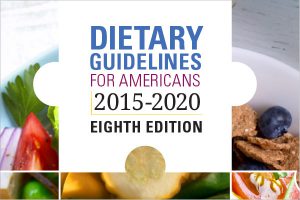By Kellie Casavale, PhD, RD, Nutrition Advisor, ODPHP
Many people make New Year’s resolutions to eat healthier, but they often need strategies and support to stick with healthy habits throughout the year. That’s why now is a great time for health care professionals to talk with patients and clients about food and beverage choices.
ODPHP offers tools and resources based on the Dietary Guidelines for Americans to help professionals promote key messages about nutrition. These user-friendly handouts are available in English and Spanish and provide go-to strategies for you to help your patients build healthier eating patterns in 2018.
Starting the Conversation
Food choices can be a touchy subject, especially after people may have gotten in the habit of indulging during the holiday season. To break the ice in a friendly way, try asking about year-round food traditions — like favorite family meals. Then be ready with responses to common barriers to healthy eating, like being too busy to cook or having picky eaters in the family.
Find more conversation starters and communication tips to help you talk with patients and clients about healthy eating patterns.
Building Healthy Habits
One reason people may give up on New Year’s resolutions is that they make unrealistic goals. Strict diets that leave no room for favorite foods aren’t always easy to maintain. That’s why it helps to remind people that there are many different ways to eat healthy, and that small changes can make a big difference to their health.
Help your patients and clients build a healthy eating pattern — one they can follow throughout the year.
Making Healthy Shifts
Telling people what not to eat can be discouraging. Instead, focus on identifying foods and beverages people can swap for healthier options. It helps to emphasize that nutritious choices can be equally delicious. Suggest simple shifts like:
- Cooking with olive oil instead of butter
- Swapping sugary soda for water
- Making sandwiches on whole-wheat bread instead of white
Share these tips to help patients and clients make healthy shifts they can stick with.
Cutting Down on Added Sugars, Sodium, and Saturated Fats
The Dietary Guidelines highlights the importance of limiting sodium, saturated fats, and added sugars. But it’s not always easy for patients to recognize the sources of these things in their diets. Patients may also have trouble understanding the recommended limits — or reject the idea of giving up their favorite foods.
By translating the limits into recognizable measurements and suggesting small changes that don’t leave patients feeling deprived, you can help them learn to reduce their intake of added sugars, saturated fats, and sodium.
Share ways for patients and clients to cut down on added sugars. For example:
- Help them spot sources of added sugars, like soda
- Teach them to find hidden names for added sugars in the ingredients list, like fructose and corn syrup
- Suggest some manageable shifts, like eating fruit for dessert instead of cookies or cakes
Show patients and clients how to limit saturated fats. You can:
- Point out ways to prepare favorite foods with less saturated fat, like grilling chicken instead of frying
- Promote healthy and satisfying sources of unsaturated fats, like seafood, avocados, and small portions of nuts
Give patients and clients tips to lower their sodium intake. For example:
- Point out common sources of sodium, like dressings and deli meats
- Remind them that even foods that don’t taste salty can be high in sodium
- Encourage low-sodium shifts, like swapping salty pretzels or nuts for unsalted ones
Checking the Nutrition Facts label is a great way to identify sources of added sugars, saturated fats, and sodium. Share this resource to help your patients use the Nutrition Facts label.
Looking Forward to a Healthy 2018
As 2018 progresses, Americans have a fresh opportunity to make healthier choices. By promoting the evidence-based food and beverage recommendations in the Dietary Guidelines, you can help people prevent chronic disease, reach or stay at a healthy weight, and build healthier eating patterns in 2018 and beyond.
Want to learn more about the Dietary Guidelines?
- Check out the Executive Summary for a more thorough overview
- Keep the Recommendations At-A-Glance handy as a quick reference




